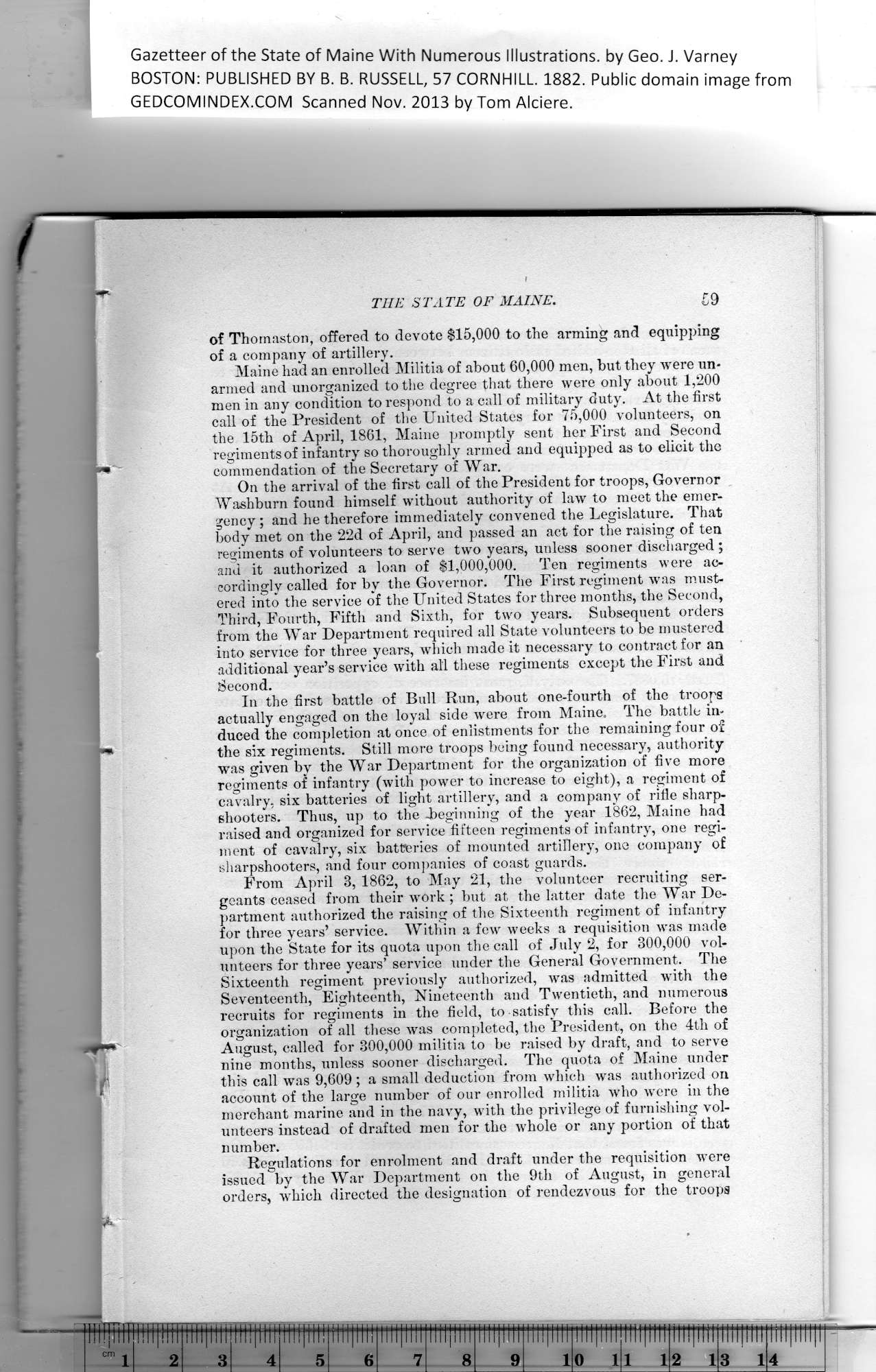|
Gazetteer of the State of Maine With Numerous Illustrations, by Geo. J. Varney
BOSTON. PUBLISHED BY B. B. RUSSELL, 57 CORNHILL. 1882. Public domain image from
THE STATE OF MAINE. 59
of Thomaston, offered to devote $15,000 to the arming and equipping
of a company of artillery.
Maine had an enrolled Militia of about 60,000 men, but they wTere un-
armed and unorganized to the degree that there were only about 1,200
men in any condition to respond to a call of military duty. At the first
call of the President of the United States for 75,000 volunteers, on
the 15th of April, 1861, Maine promptly sent her First and Second
regiments of infantry so thoroughly armed and equipped as to elicit the
commendation of the Secretary of War.
On the arrival of the first call of the President for troops, Governor
Washburn found himself without authority of law to meet the emer-
gency ; and he therefore immediately convened the Legislature. That
body met on the 22d of April, and passed an act for the raising of ten
regiments of volunteers to serve two years, unless sooner discharged;
and it authorized a loan of $1,000,000. Ten regiments were ac-
cordingly called for by the Governor. The First regiment was must-
ered into the service of the United States for three months, the Second,
Third, Fourth, Fifth and Sixth, for two years. Subsequent orders
from the War Department required all State volunteers to be mustered
into service for three years, which made it necessary to contract for an
additional year’s service with all these regiments except the First and
Second.
In the first battle of Bull Run, about one-fourth of the troops
actually engaged on the loyal side were from Maine. The battle in-
duced the completion at once of enlistments for the remaining four of
the six regiments. Still more troops being found necessary, authority
was given by the War Department for the organization of five more
regiments of infantry (with power to increase to eight), a regiment of
cavalry, six batteries of light artillei*y, and a company of rifle sharp-
shooters. Thus, up to the -beginning of the year 1862, Maine had
raised and organized for service fifteen regiments of infantry, one regi-
ment of cavalry, six batteries of mounted artillery, one company of
sharpshooters, and four companies of coast guards.
From April 3, 1862, to May 21, the volunteer recruiting ser-
geants ceased from their work ; but at the latter date the War De-
partment authorized the raising of the Sixteenth regiment of infantry
for three years’ service. Within a few weeks a requisition was made
upon the State for its quota upon the call of July 2, for 300,000 vol-
unteers for three years’ service under the General Government. The
Sixteenth regiment previously authorized, was admitted with the
Seventeenth, Eighteenth, Nineteenth and Twentieth, and numerous
recruits for regiments in the field, to satisfy this call. Before the
organization of all these was completed, the President, on the 4th of
August, called for 300,000 militia to be raised by draft, and to serve
nine months, unless sooner discharged. The quota of Maine under
this call was 9,609 ; a small deduction from which was authorized on
account of the large number of our enrolled militia who were in the
merchant marine and in the navy, with the privilege of furnishing vol-
unteers instead of drafted men for the whole or any portion of that
number.
Regulations for enrolment and draft under the requisition were
issued by the War Department on the 9th of August, in general
orders, which directed the designation of rendezvous for the troops
PREVIOUS PAGE ... NEXT PAGE
This page was written in HTML using a program written in Python 3.2
|
